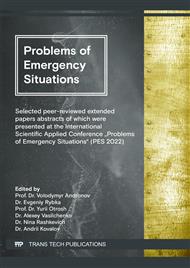p.1
p.9
p.17
p.27
p.41
Remote Visual Information System for Identification of Dangerous Substances Using Unmanned Aircrafts
Abstract:
Development of a functional model of the process of creating a knowledge base on the recognition of objects and actions of the enemy on the basis of neural networks and fuzzy logic. The aim of the work is to develop a set of software and hardware designed for remote identification of hazardous substances by machine visual recognition of information signs of dangerous goods with the output of relevant information to the means of visual display (interface). Recommendations concerning providing UAVs with the necessary technical means to monitor the zone of emergencies are analyzed. The recommendations of the organization of radio communication between the UAV and the operator depending on the range of the UAV departure, terrain conditions etc are analyzed and given. The structural scheme of the complex of remote recognition of HC in the form of blocks, units and software and hardware is developed. As a result of the analysis of programming systems, it was found that Python programming language is the best choice to ensure the full operation of the software due to the built-in capabilities and the involvement of third-party frameworks. A database containing information on more than 3.000 HCs with detailed recommendations for emergency response is developed. The hardware and software complex for remote identification of dangerous substances by machine visual recognition of information signs of dangerous goods by UAV, consisting of unmanned aerial platform with photo-video recording means, data transmission system to ground control station, PC for processing results and related software are substantiated and developed. A test of the UAV's capabilities in recognizing danger signs with UN numbers in different lighting conditions was tested. In all cases, the HC was accurately identified. The ideas and methods proposed in this article will allow to create cheap and simple tools for rescue units of Ukraine, which deal with the consequences of emergencies related to the leakage of HCs.
Info:
Periodical:
Pages:
41-49
Citation:
Online since:
July 2022
Authors:
Price:
Сopyright:
© 2022 Trans Tech Publications Ltd. All Rights Reserved
Share:
Citation:



